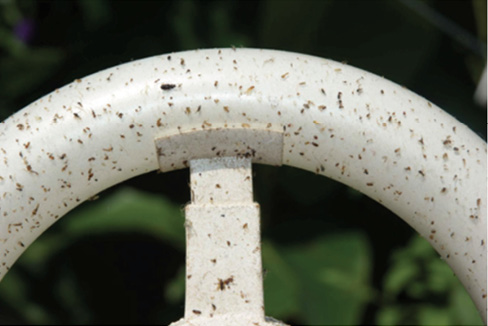
HYPOTHESIS
Kitchen lamps as a cause of mortality for urban insects
Julián Monge-Nájera
Laboratorio de Ecología Urbana, Universidad Estatal a Distancia (UNED), 2050 San José, Costa Rica, julianmonge@gmail.com
Received 26-IX-2017 • Corrected 20-X-2017 • Accepted 12-XII-2017
ABSTRACT: Fluorescent lamps in kitchens accumulate grease from cooking oil fumes and become traps for insects, particularly dipterans. New smaller lamps may be less harmful for urban insect populations.
Key words: mortality of urban insects, harmful cooking oil fumes, insects in cities.
Humans have known that insects are attracted to light for millennia, but it was Alfred Wallace who first used light systematically for scientific collection (Watson, Lyal & Pendry, 2015). Over half a century later, electric lamps began to be used for insect monitoring and elimination (Windsor, 1911; Luckiesh, Holladay & Taylor, 1929).
Some authors warned about the negative effect of artificial lights on wildlife (Saunders, 1930), which can reach mass proportions (Rodríguez, Burgan, Dann, Jessop, Negro & Chiaradia, 2014), but did not include insects. Blaho et al. (2014) reported the death of aquatic insects caused by polarized reflections in black automobiles, and here I present hypotheses about another light source of insect mortality: fluorescent lamps.
Fluorescent lamps in kitchens accumulate grease from cooking oil fumes and become insect traps (Fig. 1). This particular lamp killed over 1 000 insects in the approximately five years that it was operative in my house in Santo Domingo, Heredia, Costa Rica. Most victims were dipterans, but there were also coleopterans, formicids, homopterans and other groups (Fig. 1). My hypotheses are that kitchen lamps kill more insects than lamps in other rooms, that lamps with screens are safer, and that LED lamps are smaller and have a less negative impact on urban insect populations.
ACKNOWLEDGEMENTS
I thank Carolina Seas for the insect count and Zaidett Barrientos for clever comments.
REFERENCES
Blaho, M., Herczeg, T., Kriska, G., Egri, A., Szaz, D., Farkas, A., ... & Horvath, G. (2014). Unexpected attraction of polarotactic water-leaving insects to matt black car surfaces: mattness of paintwork cannot eliminate the polarized light pollution of black cars. PLoS One, 9(7), e103339. doi: 10.1371/journal.pone.0103339
Luckiesh, M., Holladay, L. L., & Taylor, A. H. (1929). Light-traps in the control of insects. Journal of the Franklin Institute, 208(1), 73-83. doi: 10.1016/S0016-0032(29)90941-8
Rodríguez, A., Burgan, G., Dann, P., Jessop, R., Negro, J. J., & Chiaradia, A. (2014). Fatal attraction of short-tailed shearwaters to artificial lights. PLoS One, 9(10), e110114. doi: 10.1371/journal.pone.0110114
Saunders, W. E. (1930). The destruction of birds at long point light-house, Ontario, on four nights in 1929. The Auk, 47(4), 507-511. doi: doi.org/10.2307/4075848
Watson, M. F., Lyal, C. H., & Pendry, C. A. (Eds.). (2015). Descriptive Taxonomy: The Foundation of Biodiversity Research. Cambridge: Cambridge University. doi: 10.1017/CBO9781139028004
Windsor, H. H. (Ed.). (1911). “An electric death trap for the fly”. Popular Mechanics, 16 (4), 464.
HIPÓTESIS/HYPOTHESIS
Artículos breves con hipótesis basadas en observaciones concretas, que sirvan de base a futuras investigaciones; pueden incluir pequeñas muestras y análisis estadísticos preliminares.
Short articles with observation-based hypotheses that can be a sound base for future research; they can include small samples and preliminary statistical analyses.
RESUMEN: Lámparas de cocina como causa de mortalidad de insectos urbanos. En las cocinas, las lámparas fluorescentes acumulan grasa de los vapores del aceite de cocinar y se convierten en trampas para los insectos, especialmente dípteros. Las nuevas lámparas, más pequeñas, deben ser menos dañinas para las poblaciones de insectos urbanos.
Palabras clave: mortalidad de insectos urbanos, humo de aceite de cocina dañino, insectos urbanos.

Fig. 1. Insects killed when they became trapped in the grease covering a kitchen lamp.
EDITED BY CAROLINA SEAS